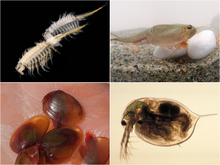Branchiopoda
| Branchiopoda Temporal range:
| |
|---|---|

| |
| Clockwise from top left: Spinicaudata )
| |
| Scientific classification | |
| Domain: | Eukaryota |
| Kingdom: | Animalia |
| Phylum: | Arthropoda |
| Superclass: | Allotriocarida |
| Class: | Branchiopoda Latreille, 1817 |
| Subclass | |
| |
Branchiopoda is a class of crustaceans. It comprises fairy shrimp, clam shrimp, Diplostraca (or Cladocera), Notostraca, the Devonian Lepidocaris and possibly the Cambrian Rehbachiella. They are mostly small, freshwater animals that feed on plankton and detritus.
Description
Members of the Branchiopoda are unified by the presence of
Ecology
Branchiopods are found in continental
Taxonomy
In early taxonomic treatments, the current members of the Branchiopoda were all placed in a single genus, Monoculus.[8] The taxon Branchiopoda was erected by Pierre André Latreille in 1817, initially at the rank of order.[9]
The current upper-level classification of Branchiopoda, according to the World Register of Marine Species (2021), is as follows:[10]
Class Branchiopoda Latreille, 1817
- Subclass SarsostracaTasch, 1969
- Order Anostraca Sars, 1867
- Suborder Anostracina Weekers et al., 2002
- Suborder ArtemiinaWeekers et al., 2002
- Order Anostraca Sars, 1867
- Subclass PhyllopodaPreuss, 1951
- Superorder Diplostraca Gerstaecker, 1866
- Order Anomopoda G.O. Sars, 1865
- Order Ctenopoda G.O. Sars, 1865
- Order CyclestheridaSars G.O., 1899
- Order HaplopodaG.O. Sars, 1865
- Order LaevicaudataLinder, 1945
- Order Onychopoda G.O. Sars, 1865
- Order SpinicaudataLinder, 1945
- Order Notostraca G. O. Sars, 1867
- Genus †Cryptocaris Barrande, 1872
- Genus †Dithyrocaris
- Superorder Diplostraca Gerstaecker, 1866
In addition, the extinct genus Lepidocaris is generally placed in Branchiopoda.
Anostraca
The fairy shrimp of the order Anostraca are usually 6–25 mm (0.24–0.98 in) long (exceptionally up to 170 mm or 6.7 in).[11] Most species have 20 body segments, bearing 11 pairs of leaf-like phyllopodia (swimming legs), and the body lacks a carapace.[12] They live in vernal pools and hypersaline lakes across the world, including pools in deserts, in ice-covered mountain lakes and in Antarctica. They swim "upside-down" and feed by filtering organic particles from the water or by scraping algae from surfaces.[11] They are an important food for many birds and fish, and are cultured and harvested for use as fish food.[8] There are 300 species spread across 8 families.[13]
Lipostraca
Lipostraca contains a single extinct Early Devonian species,
Notostraca
The order
Laevicaudata, Spinicaudata and Cyclestherida (once Conchostraca)
Clam shrimp are bivalved animals which have lived since at least the Devonian. The three groups are not believed to form a clade. They have 10–32 trunk segments, decreasing in size from front to back, and each bears a pair of legs which also carry gills. A strong muscle can close the two halves of the shell together.
Anomopoda, Ctenopoda, Onychopoda, and Haplopoda (once Cladocera)
These four
Evolution
The
See also
References
- ^ Georges Cuvier (1851). "Crustacean Entomostraca (Müller)". The animal kingdom: arranged after its organization, forming a natural history of animals, and an introduction to comparative anatomy. Translated by William Benjamin Carpenter. W. S. Orr and co. pp. 434–448.
- Wiley Publishing. 2010. Archived from the originalon October 23, 2016. Retrieved April 20, 2010.
- ^ a b c d e f Libbie Hyman (1961). "Subclass 1. Branchiopoda". The Invertebrata (4th ed.). Cambridge University Press. pp. 368–375.
- ISBN 978-0-520-00750-5.
- ^ Marine Biology: A Functional Approach to the Oceans and their Organisms
- ^ Biology of Cladocera: Proceedings of the Second International Symposium on Cladocera
- PMID 21143855.
- ^ ISBN 978-0-444-53466-8.
- ^ Pierre André Latreille (1831). Georges Cuvier (ed.). The Crustacea, Arachnides and Insecta. The animal kingdom arranged in conformity with its organization. Vol. 3. Henry M'Murtrie (trans.). G. & C. & H. Carvill.
- ^ "Branchiopoda". WoRMS, World Register of Marine Species. Retrieved 2021-11-24.
- ^ ISBN 978-0-520-23939-5.
- ISBN 978-81-7141-897-8.
- ^ S2CID 46608816.
- ISBN 978-1-84076-041-5.
- ^ "Introduction to Branchiopoda". University of California, Berkeley. Retrieved August 5, 2011.
- S2CID 25997101.
- JSTOR 92140.
- ^ "Lepidocaris". The Rhynie Chert Crustaceans. University of Aberdeen. Retrieved August 5, 2011.
- ^ J. K. Lowry (October 2, 1999). "Notostraca (Branchiopoda)". Crustacea, the Higher Taxa: Description, Identification, and Information Retrieval. Archived from the original on July 23, 2011. Retrieved February 7, 2011.
- S2CID 83523163.
- ^ a b Lakka, Hanna-Kaisa (2013). The ecology of a freshwater crustacean : Lepidurus arcticus (Brachiopoda; Notostraca) in a High Arctic region (master's thesis). University of Helsinki. p. 151.
- (PDF) from the original on 2022-10-09.
- ISBN 978-0-471-35837-4.
- S2CID 82949264.
- ISSN 2073-4441.
- ^ Joel W. Martin & George E. Davis (2001). An Updated Classification of the Recent Crustacea (PDF). Natural History Museum of Los Angeles County. pp. 1–132.
- PMID 21315832.
- PMID 22049065.
